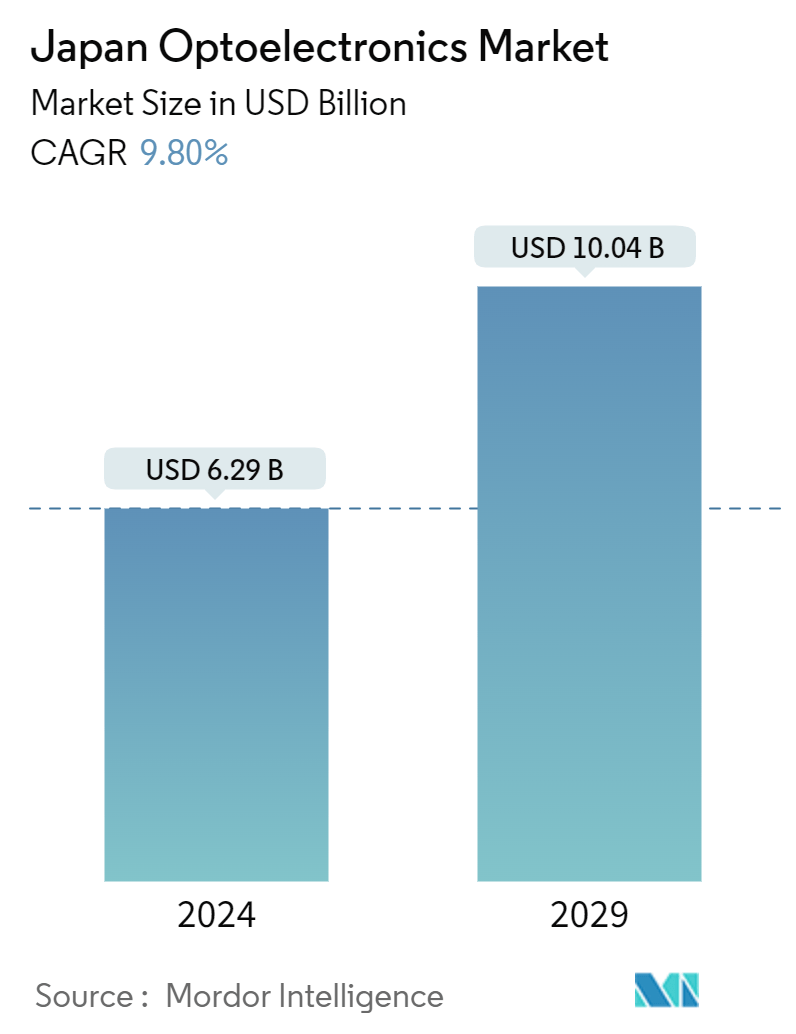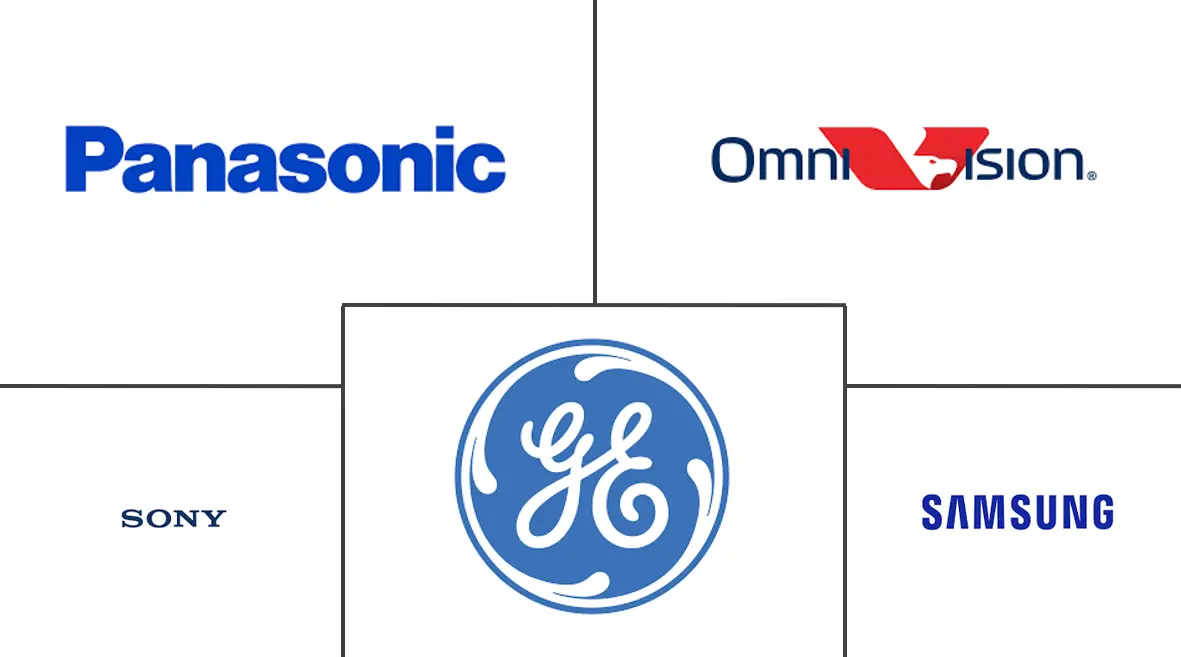Market Size of Japan Optoelectronics Industry

| Study Period | 2019 - 2029 |
| Base Year For Estimation | 2023 |
| Market Size (2024) | USD 6.29 Billion |
| Market Size (2029) | USD 10.04 Billion |
| CAGR (2024 - 2029) | 9.80 % |
| Market Concentration | Low |
Major Players
*Disclaimer: Major Players sorted in no particular order |
Japan Optoelectronics Market Analysis
The Japan Optoelectronics Market size is estimated at USD 6.29 billion in 2024, and is expected to reach USD 10.04 billion by 2029, growing at a CAGR of 9.80% during the forecast period (2024-2029).
- Optoelectronics include devices that either convert light energy to electricity or electricity to light energy. These devices account for a significant share of the semiconductors market and witness growing consumption across various verticals. In the current market scenario, two- and one-dimensional electron channels, including quantum wells and quantum wires, and cells for electrons known as quantum boxes or quantum dots, are currently being fabricated on large wafers and used in optoelectronic devices.
- The advancement in quantum semiconductor heterostructures and the progress in heterostructure technology are the immediate outcomes of the new advances in fabrication techniques in the studied market. The growing consumption of advanced manufacturing and fabricating technologies is further driving the consumption of optoelectronic components in the industrial sector, using laser and machine vision systems.
- Advances in optoelectronics have made considerable contributions to the efficient transmission of information via optical fibers (including communication between processing machines and within them), to the high-capacity mass storage of data in laser disks, and several other specific applications.
- Moreover, the increasing demand in the automotive industry, specifically with the increase in the adoption of electric vehicles, self-driven trucks, and autonomous vehicles, is expected to boost optoelectronic devices' adoption, further driving the market.
- The demand for the optocoupler is expected to pick momentum as the demand for smartphones, electric vehicles, and other optocoupler-supporting devices increases in the country are growing significantly. Optocouplers are extensively used in communications systems. In January 2022, according to the Japanese government, the United States and Japan recently signed an agreement to jointly invest approximately USD 4.5 billion to develop beyond 5G technologies. Such advancements call for efficient optocouplers in Japan.
- Further, in November 2022, Sony Semiconductor Solutions Corporation (SSS) announced the launch of a fee-based service on its edge AI sensing platform AITRIOS. The service is designed to streamline developing and implementing sensing solutions using edge devices such as AI cameras. This fee-based service comprising AITRIOS is Console Developer Edition, intended mainly to support application and AI developers working to create and operate solutions.
Japan Optoelectronics Industry Segmentation
Optoelectronics allows communication between the optics and the electronics that includes designing, studying, and manufacturing a hardware device that converts electrical energy into light energy and light into energy through semiconductors.
The Japan optoelectronics market is segmented by component type (LED, laser diode, image sensors, optocouplers, photovoltaic cells, and other component types) and by end-user industry (automotive, aerospace & defense, consumer electronics, information technology, healthcare, residential & commercial, industrial, and other end-user industries). The report offers market forecasts and size in value (USD) for all the above segments.
| By Component type | |
| LED | |
| Laser Diode | |
| Image Sensors | |
| Optocouplers | |
| Photovoltaic cells | |
| Other Component Types |
| By End-user Industry | |
| Automotive | |
| Aerospace & Defense | |
| Consumer Electronics | |
| Information Technology | |
| Healthcare | |
| Residential & Commercial | |
| Industrial | |
| Other End-user Industries |
Japan Optoelectronics Market Size Summary
The Japan optoelectronics market is poised for significant growth, driven by advancements in semiconductor technologies and increasing demand across various sectors. Optoelectronics, which involves devices that convert light to electricity and vice versa, play a crucial role in the semiconductor industry. The market is witnessing a surge in the adoption of quantum semiconductor heterostructures, which are enhancing the performance of optoelectronic devices. These devices are becoming increasingly integral in industries such as telecommunications, where they facilitate efficient data transmission through optical fibers, and in automotive applications, where they support the growing trend of electric and autonomous vehicles. The automotive sector, in particular, is experiencing a shift towards electrification, creating opportunities for optoelectronic components that ensure safe and reliable operation in high-voltage environments.
The market landscape is characterized by a diverse range of applications, from image sensors in consumer electronics to advanced sensing solutions in industrial settings. The demand for optocouplers is rising, fueled by the proliferation of smartphones and electric vehicles, which require robust communication systems. Companies like Sony and STMicroelectronics are at the forefront of innovation, introducing new products that cater to these evolving needs. The market is also seeing strategic partnerships and investments, such as the collaboration between Analog Devices and TSMC, which aims to enhance semiconductor manufacturing capabilities in Japan. As the market continues to expand, competition is expected to intensify, with major players focusing on customized solutions to meet local demands.
Japan Optoelectronics Market Size - Table of Contents
-
1. MARKET INSIGHTS
-
1.1 Market Overview
-
1.2 Industry Value Chain Analysis
-
1.3 Industry Attractiveness - Porter's Five Forces Analysis
-
1.3.1 Threat of New Entrants
-
1.3.2 Bargaining Power of Buyers
-
1.3.3 Bargaining Power of Suppliers
-
1.3.4 Threat of Substitute Products
-
1.3.5 Intensity of Competitive Rivalry
-
-
1.4 Assessment of Impact of COVID-19 on the Market
-
-
2. MARKET SEGMENTATION
-
2.1 By Component type
-
2.1.1 LED
-
2.1.2 Laser Diode
-
2.1.3 Image Sensors
-
2.1.4 Optocouplers
-
2.1.5 Photovoltaic cells
-
2.1.6 Other Component Types
-
-
2.2 By End-user Industry
-
2.2.1 Automotive
-
2.2.2 Aerospace & Defense
-
2.2.3 Consumer Electronics
-
2.2.4 Information Technology
-
2.2.5 Healthcare
-
2.2.6 Residential & Commercial
-
2.2.7 Industrial
-
2.2.8 Other End-user Industries
-
-
Japan Optoelectronics Market Size FAQs
How big is the Japan Optoelectronics Market?
The Japan Optoelectronics Market size is expected to reach USD 6.29 billion in 2024 and grow at a CAGR of 9.80% to reach USD 10.04 billion by 2029.
What is the current Japan Optoelectronics Market size?
In 2024, the Japan Optoelectronics Market size is expected to reach USD 6.29 billion.

